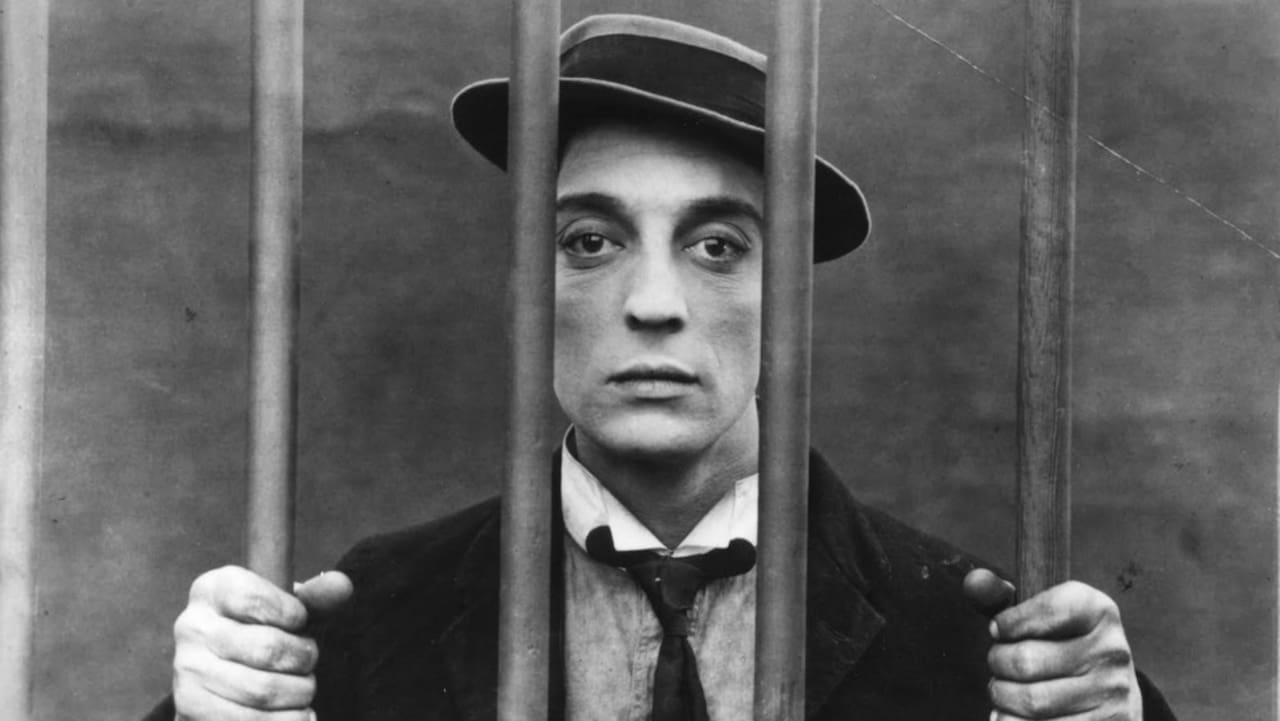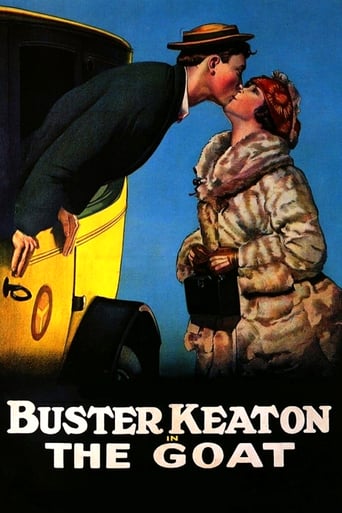

Buster Keaton is walking past a jail when he grabs the bars and peers inside. On the other side of the bars is notorious murderer "Dead Shot Dan" who is being photographed. Seeing that Keaton is behind him, Dan ducks out of shot and once he escapes, a photo of Keaton, seemly behind bars is published. As a result of this Keaton is forced to go on the run from various police officers including a persistent Police Chief who just won't give up.I watch a lot of Silent Comedy but if I had to ask someone to watch just one short silent picture it may well be this one. The Goat is packed full of wonderful jokes, ingenious set ups and incredible stunt work. I laughed more at twenty seven minutes of this film than I have during probably every comedy I've seen so far this year combined.What makes this film so great is the sheer quantity and quality of gags. While essentially a chase comedy, this is to the Keystone Cops what BBC4 is to ITV2. Sure they have similarities, but one is far more sophisticated that the other. Keaton seems to find endless possibilities in places to hide and ways of escape, only to have them backfire on him. The way that the gags join together feels effortless. Nothing about the film feels forced despite the huge number of jokes and stunts. Keaton never creates a tenuous link from one to another, the whole film feels smooth and calculated while remaining frantic and fast paced.As well as being incredibly funny, this is also quite surreal in places, in keeping with Keaton's cannon. Some of the more surreal moments include a clay horse melting under Keaton's weight and perhaps one of Keaton's most famous scenes in which a train approaches from the distance and stops immediately in front of the camera showing Keaton, stone faced, riding the cow catcher. This isn't really played for laughs but you laugh at the audacity of the shot. Perhaps the most surreal scene involves an elevator chase in which Keaton and the Police Chief (Joe Roberts) are involved in a chase through an apartment block. Keaton manipulates the mechanical elevator floor indicator to his advantage (even though this wouldn't really effect where the elevator was) and by pulling it hard and past the top floor Keaton forces the elevator out of the roof. The scene is like a cross between Charlie and the Chocolate Factory and something Terry Gilliam would produce. It's a wonderfully clever and funny scene.Something else that stands out, as with any Keaton picture, is the star's athleticism and gymnastic abilities. It sometimes seems as though Keaton is made of rubber as he jumps, falls, stretches and squeezes with ease both in and out of trouble. Keaton, who once broke his neck during a film (and didn't realise until years later when he had an x-ray) was never afraid to put himself in harms way and that is certainly true here. In The Goat he can be seen jumping through windows and off vehicles, sliding down elevator shafts and falling of a variety of apparatus. During all of this his expression never changes.To call The Goat a masterpiece would be no exaggeration. It is easily amongst the greatest silent shorts of the 1920s and amongst Keaton's best work. The humour, timing and plot don't feel out of place today. It's the sort of film that you'll be afraid to look away from for just a second or two in case you miss a gag or glance. This is comedic perfection.www.attheback.blogspot.com
... View MoreThere is a running thread in film comedy that all the great comics are just falling short of the law or on going to jail. Think of that conman's conman W.C.Fields in THE OLD FASHIONED WAY, or the Marx Brothers in A NIGHT AT THE OPERA, or Chaplin in THE ADVENTURER, of Mae West in SHE DONE HIM WRONG. The skirting of the law is inevitable, and when they end up on the side of the law the results are actually still hostile between the forces of law and order and the comic. Think of Lloyd in his first talkie, WELCOME DANGER, trying to "assist" the San Francisco Police Department in the midst of a crime wave, and making police sergeant Edgar Kennedy want to kill him. Think of Laurel and Hardy as ill-fated cops in MIDNIGHT PATROL. I find this type of hostility is so patent in all these giants' (and their peers') comedy that even a fake title for a film deals with it. Think of Jerry Seinfeld in one episode of his series creating a Three Stooges short, SAPPY PAPPIES, where the boys end up being electrocuted for murder.Buster Keaton frequently pulls in the forces of law and order to be his opponents in his comedies. Look at STEAMBOAT BILL, JR., where he tries to spring his dad from a calaboose. But he actually had more conflict from police forces in his shorts. In CONVICT 13 he is dragged back to prison when mistaken for an escaped convict. In COPS (perfect title - if you see it you'd understand) the police force of a large city is repeatedly looking for Keaton, mistaken for a terrorist). And in THE GOAT he is unable to avoid the police for most of the film.Keaton is a tramp just looking for food. But he is totally unlucky. When he sees a stranger throw a lucky horseshoe (which Keaton earlier ignored) over his shoulder, and then find a wallet full of money, Keaton tries the same thing, and hits a cop in the head. The cop gives chase, and Keaton (as luck would have it) runs into another cop, tries to act normal, but ends by throwing the other cop into the path of the first. Soon he has three cops chasing him. Briefly shaking them he walks by a window at the local jail where local murderer "Dead Shot Dan" (Malcolm St. Clair*) is being photographed. Passing in back of the barred windows, Keaton is stupid enough to stop and look straight in. The desperado notes this and ducks as the picture is taken. When Dead Shot flees the police, it is Keaton's face on all the wanted posters.(*St. Clair would eventually be a successful director of silent and early sound comedies, although in his later biography would be a stint at 20th Century Fox where his work with Laurel & Hardy was below par.)Keaton flees to another town by train (disconnecting the passenger cars containing his pursuers from the locomotive and tender). This is the film (by the way) that has two famous Keaton jokes. His arrival on the locomotive is done in a distant shot, with it coming closer and closer, and suddenly the audience sees Keaton sitting on the cowcatcher. The second famous sequence goes later (and may have influenced Chaplin somewhat in the beginning of CITY LIGHTS). Keaton had accidentally knocked out a man who was arguing too violently with a pretty woman with a dog (Virginia Fox). When he sees the poster's calling him a murderer he thinks he killed the man. He is being chased in this town by a suspicious chief of police (Joe Roberts), and momentarily loses Roberts in the park. A statue of "Man-of-War" is being constructed and the sculptor is unveiling a clay model of the horse). Keaton is seen seated on the clay model, trying to maintain his dignity as the clay legs of the horse start collapsing under his weight. Keaton manages to meet the pretty Ms Fox, who invites him home for dinner. Only he doesn't realize her father is Roberts. The last five minutes of the film deal Keaton fleeing and avoiding Roberts while he and Fox get away together.It's a funny comedy, and a wonderful example of Keaton's work at his best.
... View MoreHaving missed out on the bread line, Buster accidentally gets his photograph taken by mistake by a man taking a photo of notorious criminal Dead Shot Dan. When Dan escapes, Buster finds himself mistakenly identified as the dangerous wanted man and even when he flees the police to another town, wanted posters are already ahead of him and he finds his troubles are only beginning.BBC4 has just started a series with Paul Merton on silent comedy heroes and his first subject was Buster Keaton. The programme itself was an interesting mix of clips but the real gold was in the fact that it brought this short film in its entirety to primetime television (albeit on a small digital channel). The short opens with an unlikely setup but quickly gets past it by virtue of the sheer quality inherent in the comedy rather than the story-telling, which, being honest, is what we've come here for. True to form the comedy is creative and slightly surreal with a great mix of slapstick and wit. I found myself laughing out loud even though I wasn't really in the mood for comedy (I was more in the mood for Solaris, which I watched later the same evening).Keaton is on great form and does so much while keeping a straight face; those who dismiss his performances as just falling down simply have no idea what they are talking about and I wish them well as they watch their next crude teen comedy at their multiplex. His support cast are good in regards their physical performances but some of them really overdo their face movements not so much on the double takes (which need impact) but more on the other aspects where they appear hammy. Of course playing opposite Keaton even Mount Rushmore could be accused of overdoing the facial movements, such is his way.Overall a great little short with an unlikely plot that is more than covered up by a hilarious and inspired onslaught of physical comedy delivered with skill, imagination and wit.
... View MoreA BUSTER KEATON Silent Short.Poor Buster becomes THE GOAT ("scapegoat") for a dangerous escaped murderer.This is a wonderful, hilarious little film with Keaton at his absolute best. In what is essentially a series of chases, Buster gets to exercise his endlessly inventive imagination. Big Joe Roberts appears as the highly suspicious police chief.Born into a family of Vaudevillian acrobats, Buster Keaton (1895-1966) mastered physical comedy at a very early age. An association with Fatty Arbuckle led to a series of highly imaginative short subjects and classic, silent feature-length films - all from 1920 to 1928. Writer, director, star & stuntman - Buster could do it all and his intuitive genius gave him almost miraculous knowledge as to the intricacies of film making and of what it took to please an audience. More akin to Fairbanks than Chaplin, Buster's films were full of splendid adventure, exciting derring-do and the most dangerous physical stunts imaginable. His theme of a little man against the world, who triumphs through bravery & ingenuity, dominates his films. Through every calamity & disaster, Buster remained the Great Stone Face, a stoic survivor in a universe gone mad.In the late 1920's Buster was betrayed by his manager/brother-in-law and his contract was sold to MGM, which proceeded to nearly destroy his career. Teamed initially with Jimmy Durante and eventually allowed small roles in mediocre comedies, Buster was for 35 years consistently given work far beneath his talent. Finally, before lung cancer took him at age 70, he had the satisfaction of knowing that his classic films were being rediscovered. Now, well past his centenary, Buster Keaton is routinely recognized & appreciated as one of cinema's true authentic geniuses. And he knew how to make people laugh...
... View More